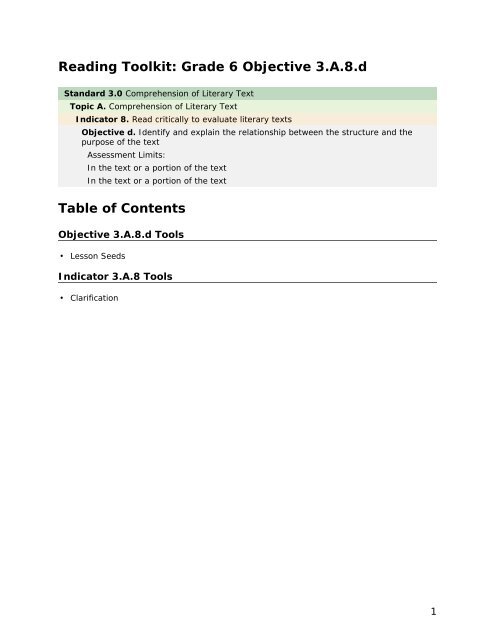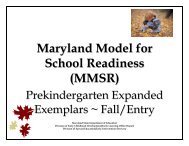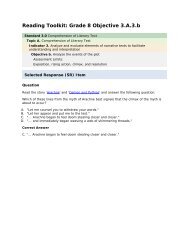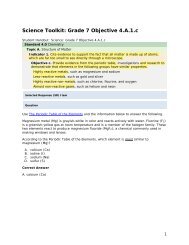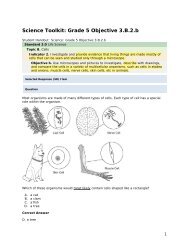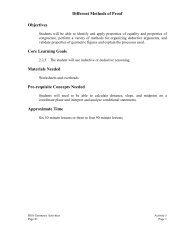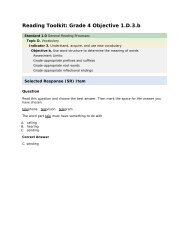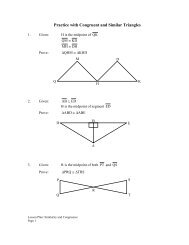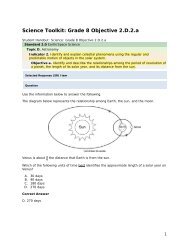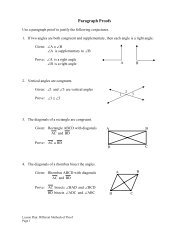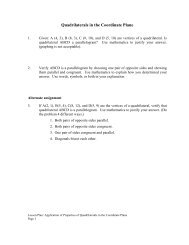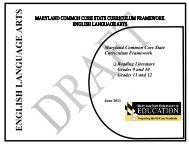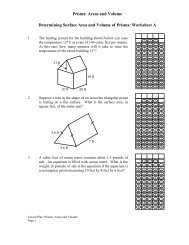Reading grade 6 3.A.8.d - mdk12
Reading grade 6 3.A.8.d - mdk12
Reading grade 6 3.A.8.d - mdk12
You also want an ePaper? Increase the reach of your titles
YUMPU automatically turns print PDFs into web optimized ePapers that Google loves.
<strong>Reading</strong> Toolkit: Grade 6 Objective <strong>3.A.8.d</strong><br />
Standard 3.0 Comprehension of Literary Text<br />
Topic A. Comprehension of Literary Text<br />
Indicator 8. Read critically to evaluate literary texts<br />
Objective d. Identify and explain the relationship between the structure and the<br />
purpose of the text<br />
Assessment Limits:<br />
In the text or a portion of the text<br />
In the text or a portion of the text<br />
Table of Contents<br />
Objective <strong>3.A.8.d</strong> Tools<br />
• Lesson Seeds<br />
Indicator 3.A.8 Tools<br />
• Clarification<br />
1
<strong>Reading</strong> Toolkit: Grade 6 Objective <strong>3.A.8.d</strong><br />
Lesson Seeds<br />
<strong>Reading</strong> Grade 6 Objective <strong>3.A.8.d</strong><br />
Activities<br />
Provide students with a complex, age-appropriate literary text. Students should silently<br />
read the text. Once reading is complete, both teacher and students should complete a<br />
literature chart like the one below.<br />
Title<br />
Key Words<br />
Feelings<br />
Ideas<br />
Images<br />
Structure<br />
When the chart is complete, the teacher and students should determine the purpose of the<br />
text from the key words, feelings, ideas, and images presented within it. Next, the teacher<br />
and students should determine and discuss whether or how the structure of the text is<br />
effective in relaying the purpose of the text.<br />
Provide students with multiple age-appropriate literary texts. Each of the texts should be<br />
structured differently but have a common idea or situation. For example, Irene Hunt's<br />
Across Five Aprils, Walt Whitman's "Captain, O My Captain," and Jim Bishop's The Day<br />
Lincoln Was Shot have a common situation, the death of Abraham Lincoln. Across Five<br />
Aprils is a novel divided into chapters. "Captain, O My Captain" is poetry, and The Day<br />
Lincoln Was Shot is journal-like in that it moves hour by hour in telling the events of that<br />
day. The structure of each text is different as is the mood, tone, and author's style.<br />
Students should read entire texts or designated portions of text and discuss the relationship<br />
between structures and purposes of the texts. After the discussion is finished, students<br />
should be able to explain how the common situation or idea is presented differently in each<br />
text and how the structure of each text helps determine that difference.<br />
Select a literary text where the structure includes a flashback. The teacher and students<br />
should read the text together, and the teacher should indicate the beginning and end of the<br />
flashback. Teacher and students should discuss the information given by the flashback and<br />
determine its purpose in the text. Does the flashback enhance the reader's understanding of<br />
a character, the setting, the mood, etc…? Next, the students should determine how the<br />
purpose of the flashback affects or reflects the purpose of the complete text.<br />
An adjusted form of the previous seed requires a literary text where the structure includes<br />
a flashback. Prior to students reading, the teacher should remove the flashback from the<br />
text. After reading, the teacher and students should discuss the literary elements in the text<br />
and determine reasons for them. Once that discussion is complete, the teacher should show<br />
students the correct placement of the flashback within the text and have them reread with<br />
the flashback in place. Once that reading is finished, the teacher and students should review<br />
their previous discussion to determine whether the altered structure of the text affects their<br />
understanding of character, setting, mood, tone etc…<br />
Content from http://<strong>mdk12</strong>.org/instruction/curriculum/reading/standard3/<strong>grade</strong>6.html 2
<strong>Reading</strong> Toolkit: Grade 6 Objective <strong>3.A.8.d</strong><br />
Clarification<br />
<strong>Reading</strong> Grade 6 Indicator 3.A.8<br />
To show proficiency of critical evaluation of literary texts, a reader must form a number of<br />
judgments about a text. To begin this process a critical reader must read a text purposefully<br />
and focus thoughts on the interaction of literary elements within the text. During and after<br />
reading, the evaluation of the text requires a reader to determine the role of the literary<br />
elements, the relationship between the text and its historical, social, or political context, and<br />
the relationship between the structure of the text and its purpose. A full critical evaluation<br />
of a literary text requires attention to each of these components.<br />
When a reader approaches a text critically, that reader is reading or listening to that text<br />
with a definite purpose and bringing to that text any prior knowledge that he or she may<br />
have. Knowing how one story is structured helps a reader understand each new story.<br />
Beginning at early stages to determine what story plot or characters are real or believable<br />
and what story plot or characters are fantasy establishes a groundwork for the more difficult<br />
determination of what plot and characters are plausible where people and events appear to<br />
be true or reasonable but often are not so. An analysis of a plot's plausibility begins with an<br />
identification of each element of a plot: introduction, rising action, climax, falling action, and<br />
resolution. A reader must decide whether each individual element is the business of<br />
everyday life or if the element is fanciful or futuristic. Once judgments about the plot<br />
elements are established, a reader needs to focus on characters. Given the background of<br />
the plot in which the character must act, a reader must analyze the character, determining<br />
whether the character's appearance, speech, and actions fit the plot. If the character does<br />
fit, the whole of the story will appear reasonable and true. If the character or an element of<br />
the plot stands out from or is in contrast to the whole of the story, the story will lose its<br />
believability.<br />
A critical reader should be able to extend thinking from the text. At early stages after<br />
reading a text, a reader should review the plot and decide what plot or character details are<br />
incomplete and form a logical question about that character or plot development. Or given<br />
incomplete plot or character details, a critical reader should be able to make a logical<br />
prediction about furthering the plot or determining a realistic course of action or a change of<br />
beliefs for a character. A critical reader could expand upon a prediction and explain how, if<br />
that prediction were to occur, it would affect the plot and characters. A more sophisticated<br />
critical reader might query whether the author purposefully left unanswered questions about<br />
plot and character development to engage a reader. To that end, a text might contain<br />
ambiguities, subtleties, and contradictions.<br />
• Ambiguity—the possibility of one or more correct interpretations of a plot development<br />
or character speech<br />
• Subtlety—the not-so-apparent difficult-to-perceive shift in a plot or development of a<br />
character that gives rise to discussion and interpretation<br />
• Contradiction—a shift of plot which belies all previous plot movements or a<br />
development of character which appears to be in direct conflict with how that character<br />
has been established<br />
To fully appreciate historical fiction, a critical reader must be aware that certain elements of<br />
plot and certain characters are true historically while others are fictional. Fictional<br />
characters and events can be written and developed to appear plausible and can serve as a<br />
realistic backdrop for true historical events and characters or the reverse can be true. The<br />
historical characters and events can serve as a backdrop for the fictional characters and<br />
Content from http://<strong>mdk12</strong>.org/instruction/curriculum/reading/standard3/<strong>grade</strong>6.html 3
<strong>Reading</strong> Toolkit: Grade 6 Objective <strong>3.A.8.d</strong><br />
events thereby making what is fictional appear more believable. Creating characters and<br />
events that are true to their historical context gives a critical reader a full picture of an<br />
historical time period.<br />
The social context of a literary work addresses the social roles of characters based upon the<br />
time period of the work. Those issues may concern gender, race, or socio-economic status<br />
and will reflect the bias of that time period. These social issues may impact character<br />
development and motivation and plot development. Creating characters and events that are<br />
true to the social context of a literary work's time period create plausibility and give a<br />
reader a broader picture of a time period.<br />
The political context of a literary work addresses how a society chooses it leaders, how rules<br />
are made and enforced and how governmental processes or decisions impact daily life. Just<br />
as political processes affect the lives of real-life citizens so do these processes when<br />
featured in a literary work affect the plot development of stories and the lives of fictional<br />
citizens.<br />
When a story is crafted that attends to the historical setting and the social and political<br />
context of a time period, a plausible re-creation of that period is presented. A critical reader<br />
receives a fully developed picture of that time with characters who respond believably within<br />
the parameters of the story. To a critical reader, themes developed in such literary works<br />
comment upon the prevailing social and political standards of that time period and invite<br />
comparison to contemporary issues.<br />
The structure of a literary work refers to its literary form. At its simplest a difference in<br />
literary form can be the difference between prose and poetry. As structure becomes more<br />
complex it can address different forms of poetry like limerick, couplet, sonnet, etc… or the<br />
difference in prose structures which can refer to the use of flashback, foreshadowing,<br />
journal entries versus chapters, sentence structure, etc…For each literary work, an author<br />
has a purpose; it can be as general as entertainment to as specific as pointing out a social<br />
injustice. For a critical reader to analyze the relationship between the structure of a literary<br />
work to its purpose, a critical reader must first read carefully to determine the author's<br />
purpose. Next, a reader will identify the structure of a literary work as specifically as is<br />
possible. Finally, a critical reader can determine whether the structure of a literary work<br />
best showcases the author's purpose and be able to explain why that structure works for<br />
that purpose.<br />
Content from http://<strong>mdk12</strong>.org/instruction/curriculum/reading/standard3/<strong>grade</strong>6.html 4


